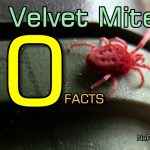
I love the outdoors and go to the woods every day. I have a few trail cameras set up in the forest to monitor the animal activity, and one day I noticed a mite on the trail camera which is by the side entrance to the Injured Badger’s Sett. It was a Red Velvet Mite (Trombidium Holosericeum).
I filmed the mite, but when I returned to the location a few days later, I found on the same camera not one, but two Red Velvet Mites. And as if that weren’t awesome enough, another of my trail cameras, which is only a few meters away, by the hole previously used by a fox, but also occasionally utilized by a feral cat, also had a Red Velvet Mite on it at the same time.
It would appear that the Red Velvet Mites took liking of my trail cameras and developed special affection for them. More power to me, because these mites, despite being bigger than most other mites, are still too small to casually spot on the forest floor. There’s just too much leaf litter, fallen tree branches and a whole host of other material of various colors among which one would not readily spot a Red Velvet Mite.
So in this video I show the Red Velvet Mites, as they cozily crawl up and down my trail cameras. At one point even having three mite explorers crawling up on two of them at the same time. I’ll be making a video on Red Velvet Mite facts shortly. Stay tuned.
Are Red Velvet Mites Harmful
Red Velvet Mites (Trombidium Holosericeum) are generally not considered harmful to humans. In fact, they are beneficial in certain ways. Here are some key points:
- Non-Harmful to Humans: Red Velvet Mites are not known to bite humans or cause any harm to people. They are more focused on preying on small arthropods and insects during their adult stage.
- Natural Predators: As adults, Red Velvet Mites play a positive role in ecosystems by acting as natural predators. They feed on small arthropods, insect eggs, and other tiny creatures, helping to control the populations of potential pests. This makes them beneficial in maintaining ecological balance.
- Temporary Parasites: While the larvae are parasitic during a specific stage of their life cycle, their parasitism is typically directed towards insects and other arthropods. Humans are not part of their usual host range during any stage of their life cycle.
- Bioindicators: In some ecosystems, the presence or absence of Red Velvet Mites can serve as a bioindicator, providing insights into the health and balance of the environment. Their sensitivity to environmental changes makes them valuable indicators of ecosystem dynamics.
It’s important to note that, as with many organisms, individual reactions and interactions can vary. While Red Velvet Mites are generally harmless to humans, it’s advisable to avoid handling them excessively, as direct contact might still cause stress to the mites or, in rare cases, lead to skin irritation for some individuals. As you can see in the video, I did not handle the mites even though I know they are not harmful to humans. My primary motivation was not to cause needless stress to the mites.
Are Red Velvet Mites Harmful to Dogs?
Red Velvet Mites (Trombidium holosericeum) are generally not considered harmful to dogs. These mites are primarily predators of small arthropods and insects during their adult stage. While their larvae can be parasitic, they typically infest and feed on insects, not vertebrates like dogs.
However, it’s worth noting that individual reactions and interactions can vary, and some dogs may be curious and attempt to investigate or even play with small creatures they encounter. In such cases, it’s advisable to monitor your dog’s behavior and prevent them from ingesting unknown or potentially harmful organisms.
If you have concerns about your dog coming into contact with any specific species of mites or if you observe any unusual behavior or symptoms in your dog, it’s always a good idea to consult with a veterinarian for advice tailored to your pet’s health and well-being.
What is the Difference Between Red Velvet Mites and Chiggers?
Red Velvet Mites (Trombidium holosericeum) and chiggers are distinct arachnids, but they share some similarities in appearance that can lead to confusion. Here are the key differences between Red Velvet Mites and chiggers:
Taxonomy:
- Red Velvet Mites: They belong to the family Trombidiidae, and the species Trombidium holosericeum is one example. These mites are part of the arachnid class and are distant relatives of ticks and spiders.
- Chiggers: Chiggers, on the other hand, are the larvae of certain mites belonging to the family Trombiculidae. Chiggers are also arachnids but are different from the Trombidiidae family to which Red Velvet Mites belong.
Appearance:
- Red Velvet Mites: These mites are typically larger, ranging from 1 to 2 millimeters in length, and are known for their bright red or orange velvety appearance.
- Chiggers: Chiggers are much smaller, usually less than 1 millimeter in size. They are red to orange in color but lack the distinctive velvety appearance of Red Velvet Mites.
Habitat and Behavior:
- Red Velvet Mites: Red Velvet Mites are often found in various terrestrial habitats, including grasslands, gardens, and forests. The larvae of Red Velvet Mites are temporary parasites of insects.
- Chiggers: Chiggers prefer more humid environments, such as tall grass, shrubs, and low vegetation. The larvae of chiggers are parasitic and may attach to the skin of animals or humans, feeding on their skin cells.
Parasitic Behavior:
- Red Velvet Mites: The larvae of Red Velvet Mites are parasitic during a specific phase of their life cycle, attaching to insects. However, they are not known to parasitize humans.
- Chiggers: Chigger larvae are parasitic on a variety of hosts, including birds, rodents, and humans. They attach to the skin, inject saliva that breaks down skin cells, and feed on the liquefied tissue.
In summary, while Red Velvet Mites and chiggers are both arachnids, they belong to different families, have distinct appearances, and exhibit different parasitic behaviors. Red Velvet Mites are generally not harmful to humans, while chiggers are known to cause skin irritation through their parasitic feeding.
What is a Typical Lifespan of a Red Velvet Mite?
The lifespan of a Red Velvet Mite (Trombidium holosericeum) typically consists of multiple stages, including egg, larva, nymph, and adult. The exact duration of each stage and the overall lifespan can vary based on environmental conditions, availability of food, and other factors. Here is a general overview of the life cycle:
- Egg Stage: The life cycle begins with the laying of eggs by adult female Red Velvet Mites. The duration of the egg stage can vary but is often relatively short.
- Larval Stage: After hatching from the eggs, the larvae emerge. During this stage, Red Velvet Mite larvae are parasitic, attaching themselves to hosts such as insects. The parasitic phase is temporary, and once they have fed and developed, the larvae detach from the host.
- Nymph Stage: After detaching from the host, the larvae molt into nymphs. Nymphs are an intermediate stage between the larva and the adult. The nymphs continue their development, undergoing further molts.
- Adult Stage: The final stage is the adult Red Velvet Mite. During this stage, they are no longer parasitic but become predatory, feeding on small arthropods and insect eggs. The adult stage is the reproductive phase of their life cycle.
The overall lifespan of a Red Velvet Mite can range from several weeks to a few months, depending on environmental conditions and the specific species. Their activity and life cycle are often influenced by factors such as temperature, humidity, and the availability of suitable hosts.
It’s important to note that the lifespan of individual mites within a population can vary, and the entire life cycle may be influenced by seasonal and environmental factors.





